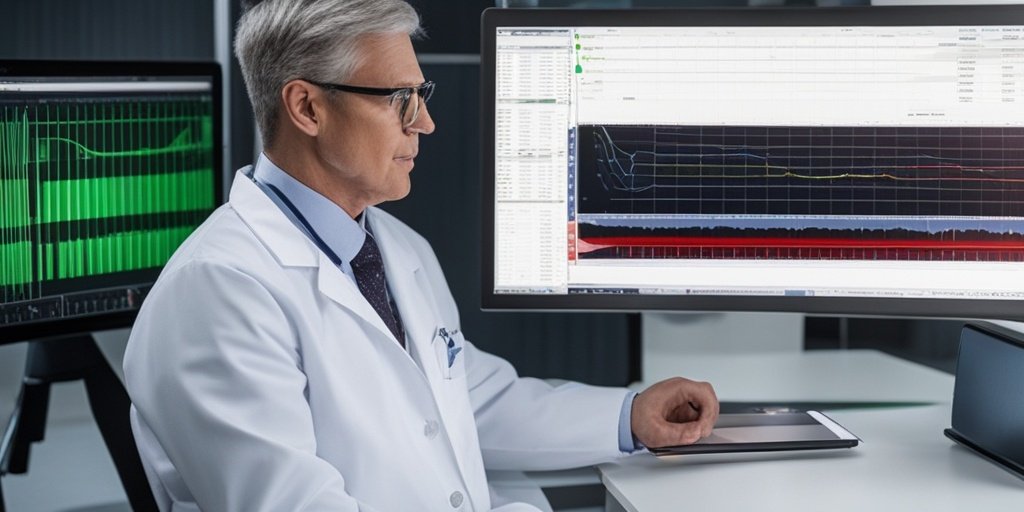⚡ Quick Summary
This study investigates the use of deep learning to enhance transmembranous electromyography (tmEMG) for diagnosing obstructive sleep apnea (OSA). The results indicate a promising potential for accurate diagnosis, with sensitivity and specificity rates reaching 98% and 73% respectively.
🔍 Key Details
- 📊 Dataset: 177 transoral EMG recordings from various patient cohorts
- 🧩 Features used: Electromyographic signals
- ⚙️ Technology: Deep learning model with transformers and attention mechanisms
- 🏆 Performance: Sensitivity 98%, Specificity 73% for neurogenic cases
🔑 Key Takeaways
- 🌙 OSA is a widespread condition that remains under-recognized and under-treated.
- 💡 tmEMG offers a painless method to assess neuromuscular function in the upper airway.
- 🤖 Deep learning techniques can effectively model and interpret complex EMG data.
- 📈 The model achieved an 82% classification accuracy for OSA patients.
- 🔍 The study highlights the potential to identify OSA endotypes related to neuromuscular pathology.
- 🏥 Clinical implications could significantly improve patient management and outcomes.
- 📚 Research conducted by a team of experts published in BMC Neuroscience.
- 🆔 PMID: 39741274.

📚 Background
Obstructive sleep apnea (OSA) is a common sleep disorder that can lead to serious health issues if left untreated. Traditional diagnostic methods, such as in-lab sleep studies, are often expensive and not widely accessible. This creates a significant barrier to effective management of OSA, which affects millions of individuals worldwide. The exploration of transmembranous electromyography (tmEMG) presents a novel approach to diagnosing this condition by assessing the neuromuscular function of the upper airway.
🗒️ Study
The study aimed to leverage deep learning to enhance the diagnostic capabilities of tmEMG. Researchers utilized a dataset of 177 transoral EMG recordings, which included samples from healthy controls, OSA patients, and individuals with neurogenic conditions. The deep learning model employed transformers and attention mechanisms to analyze the EMG signals, addressing the challenges of interpreting complex electrical signals from the upper airway.
📈 Results
The findings revealed that the deep learning model achieved a sensitivity of 98% and specificity of 73% when distinguishing neurogenic cases from controls. For classifying OSA patients, the model demonstrated a sensitivity of 88% and specificity of 64%. Notably, by averaging predicted probabilities, the model successfully classified up to 82% of both control and OSA patients, indicating its potential for accurate diagnosis.
🌍 Impact and Implications
The implications of this study are profound. By integrating deep learning with tmEMG, healthcare professionals could achieve more accurate diagnoses of OSA, particularly in identifying specific endotypes associated with neuromuscular dysfunction. This advancement could lead to improved clinical management strategies, better patient outcomes, and a more comprehensive understanding of sleep apnea’s underlying mechanisms.
🔮 Conclusion
This research highlights the transformative potential of deep learning in the field of sleep medicine. The ability to accurately diagnose OSA through non-invasive methods like tmEMG could revolutionize patient care and management. As we continue to explore the intersection of technology and healthcare, the future looks promising for enhanced diagnostic capabilities and improved patient outcomes.
💬 Your comments
What are your thoughts on the use of deep learning in diagnosing sleep apnea? We invite you to share your insights and engage in a discussion! 💬 Leave your comments below or connect with us on social media:
Deep learning enhanced transmembranous electromyography in the diagnosis of sleep apnea.
Abstract
Obstructive sleep apnea (OSA) is widespread, under-recognized, and under-treated, impacting the health and quality of life for millions. The current gold standard for sleep apnea testing is based on the in-lab sleep study, which is costly, cumbersome, not readily available and represents a well-known roadblock to managing this huge societal burden. Assessment of neuromuscular function involved in the upper airway using electromyography (EMG) has shown potential to characterize and diagnose sleep apnea, while the development of transmembranous electromyography (tmEMG), a painless surface probe, has made this opportunity practical and highly feasible. However, experience and ability to interpret electrical signals from the upper airway are scarce, and much of the pertinent information within the signal is likely difficult to detect visually. To overcome this issue, we explored the use of transformers, a deep learning (DL) model architecture with attention mechanisms, to model tmEMG data and distinguish between electromyographic signals from a cohort of control, neurogenic, and sleep apnea patients. Our approach involved three strategies to train a generalizable model on a relatively small dataset including, (1) transfer learning using an audio spectral transformer (AST), (2) the use of 6,000 simulated EMG recordings, converted to spectrograms and using standard backpropagation for fine-tuning, and (3) application of regularization to prevent overfitting and enhance generalizability. This DL approach was tested using 177 transoral EMG recordings from a prior study’s database that included six healthy controls, five moderate to severe OSA patients, and five amyotrophic lateral sclerosis (ALS) patients with evidence of bulbar involvement (neurogenic injury). Sensitivity and specificity for classifying neurogenic cases from controls were 98% and 73%, respectively, while classifying OSA from controls were 88% and 64%, respectively. Notably, by averaging the predicted probabilities of each segment for individual patients, the model correctly classified up to 82% of control and OSA patients. These results not only suggest a potential to diagnose OSA patients accurately, but also to identify OSA endotypes that involve neuromuscular pathology, which has major implications for clinical management, patient outcomes, and research.
Author: [‘Mandeville R’, ‘Sedghamiz H’, ‘Mansfield P’, ‘Sheean G’, ‘Studer C’, ‘Cordice D’, ‘Ghanbari G’, ‘Malhotra A’, ‘Nemati S’, ‘Koola J’]
Journal: BMC Neurosci
Citation: Mandeville R, et al. Deep learning enhanced transmembranous electromyography in the diagnosis of sleep apnea. Deep learning enhanced transmembranous electromyography in the diagnosis of sleep apnea. 2024; 25:80. doi: 10.1186/s12868-024-00913-9